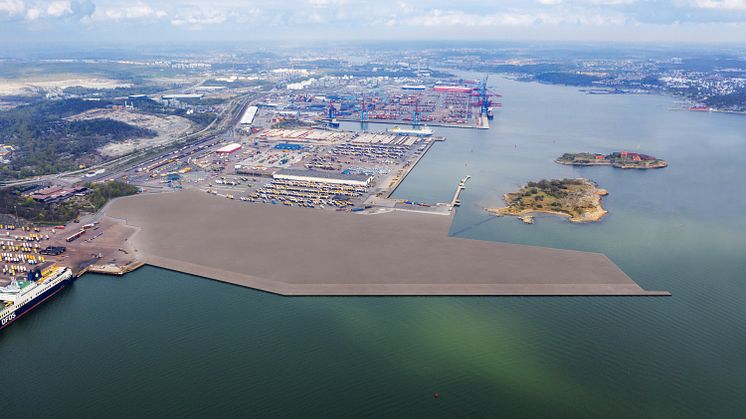
Press release -
Dredging spoils transform into new terminal at the Port of Gothenburg
180,000 cubic meters of dredged material are currently being reused as filling material in the construction of the Port of Gothenburg's next major investment. When the masses have been stabilized and solidified and further surface work have been completed, 140,000 square meters of new, long-awaited terminal space, will be available in the Port of Gothenburg.
The largest port expansion in Gothenburg since the 1970s is underway at the Port of Gothenburg. The terminal will be 140,000 square meters in size (equivalent to approximately 20 football pitches) and will be directly adjacent to other major terminals at the port.
“The terminal is a crucial aspect of the port's long-term expansion plans and will further strengthen Gothenburg as the Nordic logistics capital. By almost exclusively using recycled material in the project, we are also able to expand with environmental consideration” said Joakim Grenmarker, Project Manager at the Gothenburg Port Authority.
Construction of the brand-new terminal at the Port of Gothenburg got under way in autumn 2018. Since then, 1,500 piles have been sinked into the bedrock, and the Arendal bay has been embanked with blasting stones from an adjacent hill.
The embanked bay will constitute the coming terminal area. But first, the embanked bay will be filled with about 180,000 cubic meters of contaminated dredging spoils, and that work is currently underway.
When the material fills the basin, water is forced out and needs to be purified and checked before it is returned to the sea.
“This is done by adding carbon dioxide to the water from the backfill basin, which lowers the PH value so that pollutants can precipitate. The water is then pumped on to a sedimentation basin and on to a sand and active carbon filter. We examine and send water for analysis once a week to ensure that the water is ready to be pumped into the sea,” said Kristina Bernstén, Environmental Engineer at the Gothenburg Port Authority.
The terminal is expected to be completed by 2023, although certain sections might be brought into use before then.
Fact file: New terminal at The Port of Gothenburg
Terminal area: 220,000 square metres
Draught alongside the quay: 12 metres
Tide or ice restrictions: None
Potential rail link: Yes
Phase 2: Additional 80 000 square metres terminal surface possible
More on the project (English subtitles):
Topics
Fact file: Port of Gothenburg
The Port of Gothenburg is the largest port in the Nordic region. 30 per cent of Swedish foreign trade passes through the Port of Gothenburg as well as half of all container traffic.
The Port of Gothenburg is the only port in Sweden with the capacity to receive the world's largest container vessels and has the broadest range of shipping routes within and outside Europe. The 25 rail shuttles that depart each day mean that companies throughout Sweden and Norway have a direct, environmentally smart link to the largest port in the Nordic region. The Port of Gothenburg has terminals for oil, cars, ro-ro, containers and passengers.



